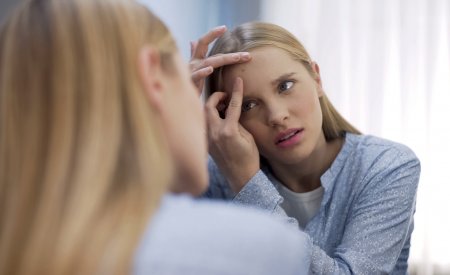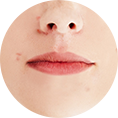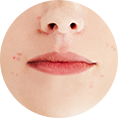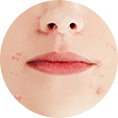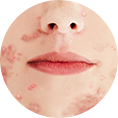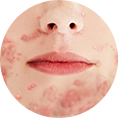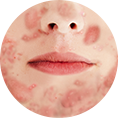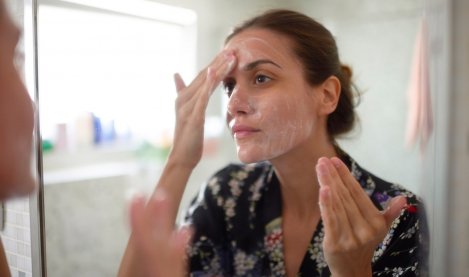Acne can take on a variety of forms based on its severity, the person’s age, the stage of progression, or the context (pregnancy, for example). Teenage acne, inflammatory acne in adults, cystic acne, hormonal acne, acne during pregnancy... dermatologists always classify acne according to its severity to determine the appropriate treatment.
In this article, you will find a handy chart that will help you improve your knowledge and easily identify the different types of acne.
Polymorphic juvenile acne
This common condition affecting adolescents is triggered during puberty. It is polymorphic in nature, i.e. characterised by pimples taking on a variety of forms. It typically starts as comedonal acne, with the appearance of blackheads and microcysts or closed comedones that are limited to the face at first. There may also be some inflammatory red spots.
Inflammatory acne in adults
Inflammatory acne often coexists with comedonal acne. It is the second stage of acne, characterised mainly by painful red spots in the form of papules and pustules. The colonisation of these pimples by the Cutibacterium acnes bacterium (previously known as Propionibacterium acnes) induces an inflammatory reaction. The pimples are located on the face (especially the T-zone and jawline) as well as on the cleavage and back, in men in particular.
Cystic acne
Here, red spots (papules and pustules) progress to form deeper lesions called nodules and cysts. Larger in size, these lesions appear as small hard lumps under the skin and can also be inflamed. Since cystic acne is very hard to treat, it is important that patients consult a dermatologist. The pimples are inaccessible and can cause significant scarring.
Hormonal acne
It’s true, acne is always hormonal since sebum secretion is controlled by hormones. But there are cases when the condition is caused by a hormonal imbalance, for example the over-production of male hormones.
- The female menstrual cycle also plays a major role in acne, with pimples becoming worse during the premenstrual period. 50%1 of adult women with acne observe changes in their acne during their cycle with breakouts occurring 7 to 10 days before their period begins.
- Acne during pregnancy is also largely due to the hormonal disruptions taking place during this period. It affects 42% of women according to a study undertaken by the Nantes University Hospital Centre2. Unfortunately, it only disappears after childbirth for half of these women...
Not all of the hormonal mechanisms at play in acne are completely understood, and researchers are currently working to improve knowledge of the persistence of acne in adult women in particular.
1. E. Shimer Bowers, “How Your Period Affects Acne,” WebMD, 2011. [Online]. Available: http://www.webmd.com/skin-problems-and-treatments/acne/features/period. [Accessed: 11-Jun-2015].
A. W. Lucky, “Quantitative documentation of a premenstrual flare of facial acne in adult women.,” Arch. Dermatol., vol. 140, no. 4, pp. 423-4, Apr. 2004.
2. Dreno B, Blouin E, Moyse D. Acne in pregnant women: a french survey. Acta Derm Venereol, 2014;94:82-3
Other types of acne
There are also some rarer forms of acne that can be very severe:
- acne conglobata is a condition in which large numbers of pimples and lesions of all types develop, with a high risk of scarring. It affects the face, back, shoulders and thorax and occurs mainly in young males.
- acne fulminans has a sudden and abrupt onset and affects males between the ages of 15 and 30. This is the most severe form of acne and requires hospitalisation. It presents with cysts and nodules accompanied by fever and joint pain.
- drug-induced acne is a reaction to a medication. It can be caused by corticoids, certain types of antidepressants, anti-tuberculosis drugs, vitamin B12 (often taken by vegans), and many other treatments.
- contact acne can be caused by simply being in contact with certain highly comedogenic chemical products used in industry and in certain professional sectors.
- acne cosmetica is very widespread and is caused by the use of unsuitable cosmetic, cleansing or make-up products. Either the skin is too stripped and reacts, or the layering of creams, foundations and powders ends up creating an occlusive film that smothers the skin. This type of acne can aggravate traditional pre-existing acne.
How do i know if my acne is severe?
Acne is often described as being mild, moderate or severe. Here is how the various acne severity levels are assessed according to the French Dermatology Society (SFD).

